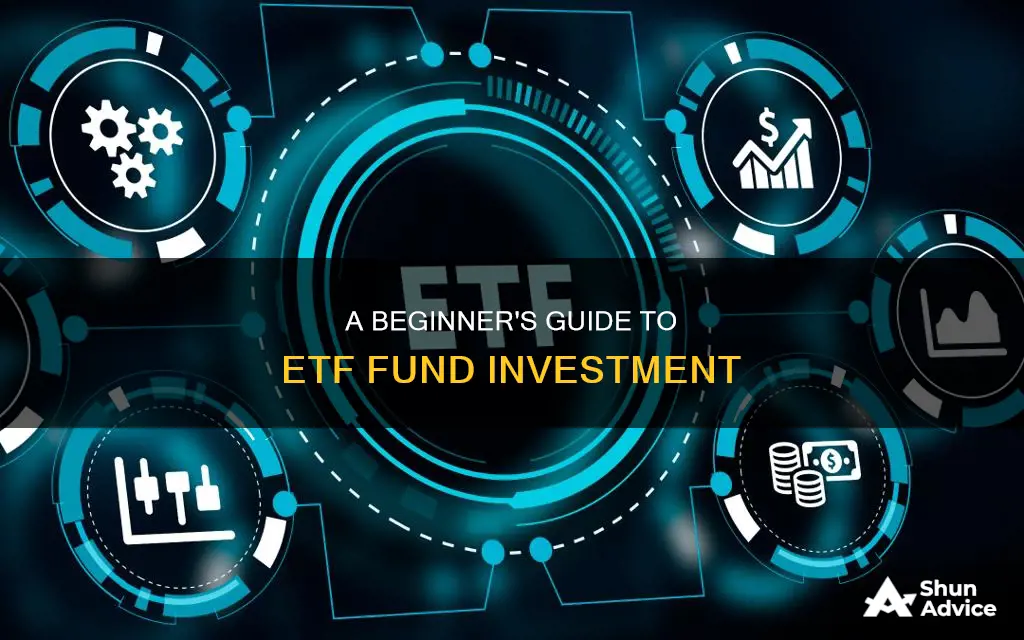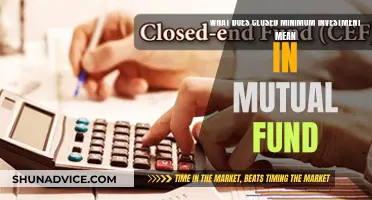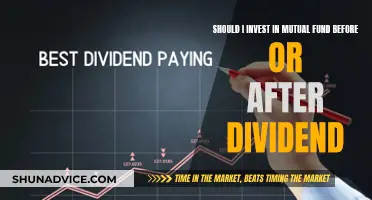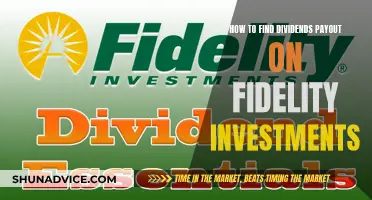
Exchange-traded funds (ETFs) are a great way for beginners to get into investing. They are fairly simple to understand and can generate impressive returns without requiring much expense or effort. ETFs are a low-cost way to buy exposure to hundreds or thousands of stocks and bonds, making them a favourite of financial advisors and investors alike.
ETFs are similar to mutual funds in that they hold a collection of stocks and bonds in a single fund. However, unlike mutual funds, they are bought and sold on stock exchanges and can be traded anytime the exchange is open. They also tend to be less risky than investing in individual stocks.
1. Open a brokerage account.
2. Decide on your ETF investment strategy.
3. Research your ETFs.
4. Fund your account.
5. Search for the ETF ticker symbol.
6. Enter the number of shares you want to buy.
7. Confirm the order.
8. Set up your purchase plan.
9. Decide on your exit strategy.
| Characteristics | Values | |
|---|---|---|
| Definition | Exchange-traded funds (ETFs) are a type of index fund that can be traded like an individual stock on an exchange. | A basket of securities that trades on an exchange just like a stock does. |
| Benefits | ETFs are a low-cost way to buy exposure to hundreds or thousands of stocks and bonds. They are great for beginners and provide diversification, which minimises risk. | ETFs are cheaper than mutual funds and individual stocks. They are also more liquid and easier to buy and sell. |
| Types | Passive ETFs, Active ETFs, Bond ETFs, Stock ETFs, Industry or Sector ETFs, Commodity ETFs, Currency ETFs, Bitcoin ETFs, Ethereum ETFs, Inverse ETFs, Leveraged ETFs | Passive ETFs aim to replicate the performance of a broader index. Active ETFs have portfolio managers making decisions about which securities to include. Bond ETFs provide regular income to investors. Stock ETFs aim to provide diversified exposure to a single industry. Industry or Sector ETFs focus on a specific sector or industry. Commodity ETFs invest in commodities like crude oil or gold. Currency ETFs track the performance of currency pairs. Bitcoin and Ethereum ETFs expose investors to cryptocurrency prices. Inverse ETFs earn gains from stock declines by shorting stocks. Leveraged ETFs seek to return multiples on the return of the underlying investments. |
| Expense Ratio | The expense ratio indicates how much of your investment in a fund will be deducted annually as fees. | Between 0% and 0.52% |
| Brokerage Account | You need a brokerage account to buy and sell ETFs. | Examples: TD Ameritrade, E*Trade, Schwab, Fidelity, Interactive Brokers, Betterment, Wealthfront |
| Investment Strategy | You need to determine your asset allocation, or what percentage of each type of investment security you want to reach your goals. | Split your investing dollars between conservative bond ETFs and aggressive stock ETFs. |
| Research | You need to research ETFs to help you reach your goals. | Choose indexes that reflect your asset allocation. Stock-based indexes, like the S&P 500, NASDAQ and Dow Jones Industrial Average, are good starting points. If you want to pursue specific sectors, consider indexes that track segments of the market, like large-cap, mid-cap or small-cap companies or international/emerging markets stocks. |
| Purchase | The process for buying ETFs is similar to the process for buying stocks. | Fund your account, search for the ETF ticker symbol, enter the number of shares you want to buy, and confirm the order. |
What You'll Learn

Choose a brokerage account
The first step to investing in an ETF is to open a brokerage account. You can do this online, and many brokers offer no account minimums, transaction fees, or inactivity fees.
When choosing a brokerage account, you should consider the following:
- Fees: Look for brokers that don't charge maintenance, administration, or stock trading fees.
- Minimum deposit: Choose a broker with an affordable minimum deposit or no minimum at all.
- Types of assets: Ensure the broker allows you to purchase the types of investments you're interested in, including ETFs and other assets.
- Customer service: Consider the level of help and responsiveness offered by the broker.
- Special features: Look for brokers that offer additional features such as automatic tax-loss harvesting or portfolio rebalancing.
Some popular brokerage accounts for ETF investing include TD Ameritrade, E*Trade, Schwab, Fidelity, and Interactive Brokers. These brokers provide fractional share investing, allowing you to buy ETFs with a small amount of money.
If you want a more hands-off approach, you can consider using a robo-advisor. Robo-advisors construct diversified portfolios of ETFs and provide automated portfolio rebalancing. However, you'll typically pay a management fee of around 0.25% of your invested amount.
Fidelity Mutual Funds: Investing in Corporate Debt
You may want to see also

Understand ETF basics
Understanding ETF basics
Before investing in your first ETF, there are a few concepts that are important to know.
Passive vs. active ETFs
There are two basic types of ETFs. Passive ETFs (also known as index funds) simply track a stock index, such as the S&P 500. Active ETFs hire portfolio managers to invest their money. Passive ETFs want to match an index's performance, while active ETFs want to beat it.
Expense ratios
ETFs charge fees, known as the expense ratio. You'll see the expense ratio listed as an annual percentage. For instance, a 1% expense ratio means that you'll pay $10 in fees for every $1,000 you invest. All things being equal, a lower expense ratio will save you money.
Dividends and DRIPs
Most ETFs pay dividends. You can choose to have your ETF dividends paid to you as cash, or you can choose to have them automatically reinvested through a dividend reinvestment plan, or DRIP.
ETF taxes
If you buy ETFs in a standard brokerage account (not an IRA), you should know that they could result in taxable income. Any gains you make from selling an ETF will be taxed according to capital gains tax rules, and any dividends you receive will likely be taxable as well.
Of course, if you invest in ETFs through an IRA, you won't have to worry about capital gains or dividend taxes. In a traditional IRA, money in the account is only considered taxable income after it is withdrawn, while Roth IRA investments aren't taxable at all in most cases.
Venture Capital Funds: Smart Investment for Future Growth
You may want to see also

Understand ETF taxes
If you buy ETFs in a standard brokerage account (not an IRA), you should be aware that they could result in taxable income. Any gains you make from selling an ETF will be taxed according to capital gains tax rules, and any dividends you receive will likely be taxable as well.
However, if you invest in ETFs through an IRA, you won't have to worry about capital gains or dividend taxes. In a traditional IRA, money in the account is only considered taxable income after it is withdrawn, while Roth IRA investments are typically not taxable at all.
ETFs have two major tax advantages over mutual funds. If you invest in a mutual fund, you may have to pay capital gains taxes (or, the profits from the sale of an asset, like a stock) through the lifetime of your investment. This is because mutual funds, particularly those that are actively managed, often trade assets more frequently than ETFs. Most ETFs, on the other hand, only incur capital gains taxes when you go to sell the investment. This means you'll pay less tax on your ETF investment overall.
As mutual fund managers are actively buying and selling investments, and incurring capital gains taxes along the way, the investor may be exposed to both long-term and short-term capital gains tax. If you're invested in an ETF, you get to decide when to sell, making it easier to avoid those higher short-term capital gains tax rates.
ETFs are also more tax-efficient than mutual funds. Redeeming shares of a fund can trigger a tax liability, so listing the shares on an exchange can keep tax costs lower. In the case of a mutual fund, each time an investor sells their shares, they sell them back to the fund and incur a tax liability that must be paid by the fund's shareholders.
Mutual Funds: Why They're a Popular Investment Choice
You may want to see also

Decide on your ETF investment strategy
Once you have a brokerage account, it's time to decide how you want to invest in it. First, you'll need to determine your asset allocation, or what percentage of each type of investment security you'll want to reach your goals. You'll generally want to split your investing dollars between conservative bond ETFs and aggressive stock ETFs. Bond ETFs offer more modest returns but provide stability in value. Stock ETFs, on the other hand, have greater growth potential but may experience larger fluctuations in value in the short term.
Those value changes are why financial advisors recommend using your timeline as a guide for your asset allocation. The further away your goal, the more time you have to recover from any short-term stock ETF dips. The closer it is, the more you'll probably want to lock in its value with bond ETFs that are unlikely to experience fluctuations.
Of course, you'll also want to consider how willing you are to take on the potential to lose money for greater gains—a financial concept called risk. If you're unwilling to take on much risk, even for a longer-term goal, you might invest more conservatively. This simply means you'll have to contribute more of your own money to reach your goals instead of relying on investment gains.
Here's how that might play out for saving for retirement, according to investment management firm T. Rowe Price:
20s & 30s: 90% to 100% stocks, zero to 10% bonds
40s: 80% to 100% stocks, 0 to 20% bonds
50s: 65% to 85% stocks, 15% to 35% bonds
60s: 45% to 65% stocks, 30% to 50% bonds, 0 to 10% cash/cash equivalents
70+: 30% to 50% stocks, 40% to 60% bonds, 0 to 20% cash/cash equivalents
ETF asset allocation
Once you've decided on an ETF asset allocation, you'll need to research the ETFs most likely to help you reach your goals. Your brokerage should offer ETF research tools, like a database you can screen for particular indexes or strategies. You can also use third-party databases, like ETFdb.com.
You'll want to keep a couple of things in mind as you look for ETFs:
- Almost all ETFs seek to copy the performance of indexes. You'll want to choose indexes that reflect the asset allocation you're aiming for. Stock-based indexes, like the S&P 500, NASDAQ and Dow Jones Industrial Average, are good starting points for the stock component of your portfolio.
- If you want to pursue specific sectors, you might consider indexes that track segments of the market, like large-cap, mid-cap or small-cap companies or international/emerging markets stocks. These may carry more risk than a broad index like the S&P 500, but they may also offer higher returns.
- For the bond-based part of your portfolio, look to indexes like the Barclays Capital U.S. Aggregate Bond Index. You may consider indexes that focus on Treasury-backed securities for even less risk. The U.S. government's history of repaying its debts means these are about the lowest-risk investments you can find.
Because ETFs almost always track an index, their fees are much lower than actively managed funds. You'll still want to keep an eye out for their expense ratios, though. These can vary across providers, and you'll want to choose the ETFs with the lowest possible operating fees because ETFs tracking a particular index will have nearly identical performance, regardless of their cost. Make sure your brokerage of choice will allow you to trade your selected ETFs fee-free as well.
Hedge Fund Managers: Where to Find Their Investment Theses
You may want to see also

Research your ETFs
Researching your ETFs is an important step in the process of investing in an ETF fund. Here are some key things to keep in mind:
Understand the Basics
Before investing in ETFs, it's important to understand the basics of how they work. ETFs, or exchange-traded funds, are baskets of securities that are traded on an exchange, just like stocks. They can be structured to track a specific index, such as the S&P 500, or a collection of securities. ETFs offer diversification, low expense ratios, and fewer broker commissions compared to buying individual stocks.
Compare Different Types of ETFs
There are two main types of ETFs: passive and active. Passive ETFs, also known as index funds, aim to replicate the performance of a particular stock index. On the other hand, active ETFs hire portfolio managers to actively manage the fund and try to beat the market's performance. Passive ETFs tend to have lower fees, while active ETFs aim for higher returns.
Evaluate the Underlying Index
When choosing an ETF, it's crucial to look beyond the expense ratio and consider the underlying index that the ETF is tracking. Different indexes can have significantly different holdings and performance. For example, the S&P 500 and the Dow Jones Industrial Average have very different compositions, with the latter holding only 30 stocks. Make sure the holdings, sector, and country breakdowns of the ETF align with your investment goals and desired asset allocation.
Consider Trading Activity and Liquidity
The trading volume of an ETF is an indicator of its liquidity. Generally, ETFs with higher trading volumes are more liquid and have tighter bid-ask spreads. However, even ETFs with limited trading volume can be liquid if their underlying securities are liquid, such as an ETF that invests in S&P 500 stocks.
Analyse Tracking Difference
While most ETFs aim to track their underlying indexes closely, some may deviate due to expenses and the performance of the index. It's important to compare the performance of the ETF to its underlying index, taking into account factors such as transaction costs and the management skills of the ETF provider.
Evaluate Risk and Return
When evaluating different ETFs, consider the level of risk and potential return. Some ETFs, such as leveraged ETFs, provide higher returns but also come with higher risk. Inverse ETFs, for example, rise when the market falls and are designed to profit from market declines. It's important to understand the investment strategy and potential risks before investing.
Convince Your Family to Invest in Hedge Funds
You may want to see also
Frequently asked questions
An exchange-traded fund (ETF) is a basket of securities that trades on an exchange just like a stock. ETFs can be structured to track anything from the price of a commodity to a large and diverse collection of securities.
You'll need to open a brokerage account and decide on your ETF investment strategy. Then, you can research and choose your first ETFs.
ETFs don't have minimum investment requirements. However, ETFs trade on a per-share basis, so you'll need at least the current price of one share to get started (unless your broker offers fractional shares).
An ETF's expense ratio indicates how much of your investment in a fund will be deducted annually as fees.







